Crime rates are a critical way to determine the safety provisions within an area, and they are collected to analyze and tackle the rising issue. These trends provide much insight into the contributing factors to the rise or fall of crime.
In a country such as Canada, the results of questions on crime rates, youth crime, and whether Canada is too soft on crime are intriguing. Since Canada is generally regarded as a country with a lower crime rate, these crime trends are fairly interesting. The article will examine the country’s more recent crime rate trends.
Key Facts
- According to a Statistics Canada report, in 2021, there was a 5% rise in violent crimes and a 3% fall in non-violent crimes compared to the year prior.
- The most common crimes in Canada observed from 2020 to 2021 included
- Homicides,
- Fire-arm-related offenses,
- Illegal extorsions
- Sexual assault.
The statistics were the findings of a Statistics Canada report.
- From the year 2000 to 2020, Canada experienced a 53% decrease in the youth crime severity index, according to Statistics Canada.
- The Trumped stated in its 2022 article that Canada’s crime rate might have increased benevolence to its ‘reasonable’ bail conditions.
- According to a 2019 CBC article, experts stated crime rises due to poverty and income inequality, which would apply in Canada.
- According to a poll held by the government of Canada in 2022, 79% of people stated they believed Canadian laws were too lenient.
What Is the Crime Trend in Canada?
Recent crime trends in Canada pose interesting statistics on the country and its crime rates. We can dissect overall crime trends by analyzing these criminal activity levels. They can help determine which crimes are on the rise and which are on the fall.
The categorization will help demonstrate a more holistic picture of the country’s crime rates.
Is the Overall Crime Rate Rising or Falling?
Statistics Canada is the national statistics office of Canada responsible for the production of data. According to a report of 2021 on police-reported crime in Canada, the volume of crime had a 1% decrease.
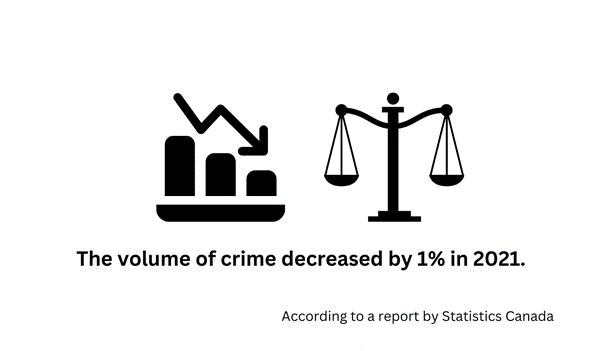
The above-mentioned report used the Crime Severity Index (CSI), which monitors police-reported crime, including violent and non-violent crimes. CSI is measured yearly and provides weightage to each crime based on its seriousness. A change occurs in the percentage of crime based on the increase or decrease in the volume of crime. It shows whether police-reported crimes were more or less serious than the previous year. It had the following findings:
- The CSI changed from 73.9 in 2020 to 73.7 in 2021.
- The result stems from an increase in violent crime but a decrease in non-violent crimes. Violent CSI rose by 5% in 2021. The increase predominantly was caused by an 18% increase in level 1 sexual assault.
- Non-violent CSI, on the other hand, decreased by 3% in 2021, which includes property or drug offenses. The decline was largely a result of a 10% decrease in breaking and entering and a 4% decrease in the theft of under $5000.
- The decrease in non-violent crime led to a lower CSI, even with a 5% increase in violent crimes.
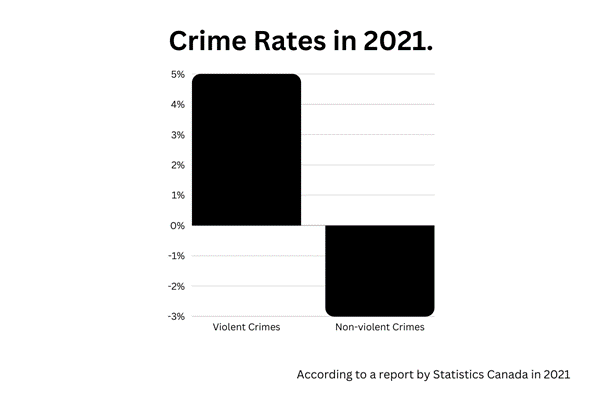
When segregating crimes based on regions in Canada, we acquire extensive knowledge of the crime trend in Canada.
Manitoba
A report by Statistics Canada on the Crime Severity Index and provinces covered Manitoba. The report had the following data:
- Manitoba had a crime severity index of 126.9 in 2021, which was 0.82% more than the year prior.
- The violent crime severity index of Manitoba was 182.46 in 2021. The index was 6.70% higher than the year before.
- In 2021, the non-violent severity index of the province was 106.64, which was -2.43% compared to 2020.
Alberta
Statistics Canada published many details on the region of Alberta and the violations taking place there in a 2022 report. It stated that the rate in Alberta for all violations was reported to be 8,306.51 per 100,000 population in 2021, experiencing a 5.68% decline from the previous year.
On the other hand, the report also showed the rate per 100,000 population for all criminal code violations (including traffic offenses). The rate of Alberta in 2021 was 8,117.17 per 100,000 thousand population. The rate was 5.35% less than the previous year.
Ontario
In the report mentioned above, all violations in Ontario were also published. The report stated that the rate of violations per 100,000 population taking place in Ontario was 4170. The region went through a 3.25% rise in the percentage.
Ontario’s total criminal code violations per 100,000 population were 3,860.16 in 2021. The province experienced a 3.55% increase since 2020.
British Columbia
British Columbia’s government forum published a report in 2021 on the crime statistics of the province. It had the following findings:
- Police-reported crime decreased by 3.9% from the previous year (the criminal offenses, (not including traffic offenses) in British Columbia.
- British Columbia had a 92.9% overall crime severity index, which was 4% lesser than in 2020.
Which Crimes Are on the Rise?
Throughout the years, Canada has experienced various trends in relation to different classifications of crime. Interestingly, Canada has seen an increase in violent crimes throughout recent years. According to the above-mentioned report, in 2021, Canada faced staggering crime statistics. Police reported cases in 2021 were as follows.
- A total of 788 homicides took place in 2021, which was reported to be 29 more than in 2020, and the rate of homicides increased by 3%.
- 41% of homicides were firearm-related in 2021, which totaled 296 fire-arm related homicides.
- 46% of fire-arm related homicides were reported to be gang-related.
- Three thousand three hundred sixty occurrences or a 27% increase in hate crimes was observed. There was a 72% increase in crimes targeting religion, sexual orientation, and religion over the two years prior to 2021.
- Opiod-related offenses rose by 13% in comparison to the year prior.
Another report by Statistics Canada analyzed the homicide trends within Canada in 2021. The report had the following results:
- There had been a rise in the homicide rate for a third year consecutively.
- It further stated a quarter of homicides were a result of gang-related circumstances, showing a clear pattern.
- Saskatchewan, a province in Canada, had the highest rate of homicides and gang-related murders and experienced a 9% rise from the prior year.
- Manitoba had the second-highest rate of homicides and gang-related murders.
- Other provinces also followed this trend, with a large increase in the homicide rate.
- Homicide, however, only made up 0.2% of police-reported violent crimes.
Furthermore, there was an increase in hate crimes, as reported by Statistics Canada report. It showed the rise in criminal offenses that stemmed from prejudice and hate.
- Hate crimes targeting religious groups, such as Muslims or Jews, increased by 67%.
- Sexual-orientation-based hate crimes had a rise of 64%.
- Ethnicity and racial-based hate crimes had a 6% increase.
Which Crimes Are Decreasing?
While there are crimes that experienced a higher rate than the previous, Canada also experienced a fall in many of its crime rates. The Statistics Canada report dwelled on the crimes which experienced a decline in 2021, such as the following:
- Property expenses in 2021 experienced a drop of 3% than of 2020.
- Drug offenses underwent a 9% decrease in the year.
- Break-in incidents declined by 10%.
- Theft of $5000 and under had a 4% decline rate.
- Drug offenses related to heroin, ecstasy, methamphetamine, etc., fell. Heroin-related offenses declined by 32%. Ecstasy-related offenses declined by 25%. Methamphetamine-related crimes experienced a 20% decline.
- Cocaine-related drug offenses declined by 15%.
A Biased View
However, some sources state that one can only partially rely upon the figures presented. This is because these figures only represent crimes reported to the police. The John Howard Society of Canada is pivotal in raising awareness about societal issues. Their objective is to play their part in ensuring the welfare of society and press for the enforcement of criminal laws.
One of their blogs, published on April 30, 2022, states that ‘reported crime’ is seen to decrease; however, a conclusion cannot be derived without considering the number of unreported cases. According to the General Social Survey, only 30% of crimes get recorded. Even more, crimes such as hate-driven ones tend to get more attention from the police compared to other generic crimes. This, too, creates a false notion that the crime rate is decreasing as there are many areas within Canada where police investigation is not as effective.
What Are the Most Common Crimes in Canada?
The data for answering this question based on recent statistics was quite limited. What follows is one of the few worth mentioning.
According to an article by Statistics Canada, the most commonly observed crimes in the period 2020 to 2021 include:
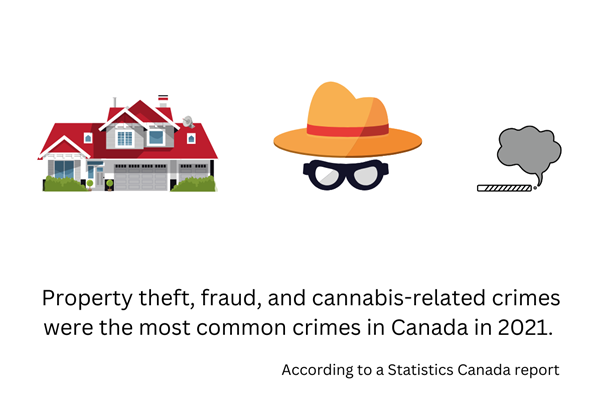
- Property crimes, especially breaking and entering, were quite common in 2021. There were 125,500 cases of break-ins reported to the police in the year.
- Fraud is also a high-volume crime that contributed to the CSI of the country for the same year.
- Cannabis-related offenses, especially those related to exportation and importation, were also prevalent.
What Is the Current Trend of Youth Crime in Canada?
Another report by the Government of Canada cited that the age group of 18-24 years had the highest rate of criminal offenses compared to other age groups. Although this figure is from 2016, it contains the most relevant data available.
Mass Tsang LLP is a criminal defense law firm with over 1000+ successfully handled cases. They published a report in 2021 outlining the most common youth offenses in Canada. They reported trends in youth offenses, citing the youth crime severity index in 2020. According to the report, from 2000 to 2020, the rate of youth accused by the police declined by 63%.
At the same time, the youth crime severity index fell by 53%. The youth crime severity index measures the volume and severity of the crime in relation to the accused youth.
The article further dwelled on the 2019-2020 crime rate decline in youth crime rates. It stated:
- The youth violent crime rate declined by 24%.
- The youth crime rate relating to robbery dropped by 31%.
- Breaking and entering by youth rate decreased by 25%.
- Theft under $5,000 committed by youth had a 44% decrease.
- Shoplifting under $5,000 committed by youth followed a decline of 64%.
- The failure to comply with legal orders by youth experienced a 31% decrease.
- Simple Assault offenses by youth declined by 27%.
- Level 1 sexual assault by the youth fell by 13%.
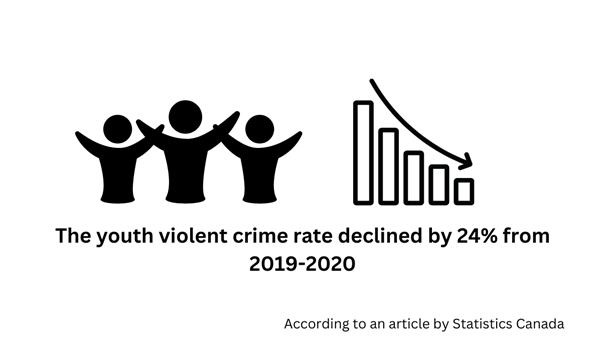
Statista is a notable organization that provides statistics for various countries worldwide. It includes data from over 170 industries.
We can find further insight in their report. It demonstrated that the youth crime severity index decreased from 2000 to 2021. The decrease varies slightly, with minimal increases in 2017, 2019, etc. However, the highest CSI recorded was 106.03 in 2003, and the lowest was 40.96 in 2021.
Even more, violent crime has seen a varied trend from 2000-2021 among Canadian youth. In another collection of figures, violent crime among the youth in 2021 was around 64.2. The highest was 102.05 in 2007, and the lowest was in 2021.
The Most Common Crimes Committed by the Youth
Mass Tsang LLP’s article on the most common crimes committed by the youth outlined common youth offenses before the pandemic. These include
- Uttering threats
- Assault with a weapon or causing bodily harm
- Theft of under $5,000
- Breaking and entering
- Robbery
- Sexual assault
- Disturbing the peace
- Total drug offenses
We can qualify this list by also adding data on the same subject by the Statistics Canada report mentioned above. According to the report, the most common crimes committed by the youth and their CSIs were:
- Level 1 Assault – 394. This type of assault involves pushing, slapping, punching, and face-to-face verbal threats.
- Mischief – 309
- Administration of justice violations such as breach of probation and failure to appear – 197
- Level 2 Assault – 166. This type of assault involves carrying, using or threatening to use a weapon against a person or causing someone physical harm.
- Uttering threats – 156
- Shoplifting of $5,000 or under – 115
What Canadian City Has the Highest Crime Rate?
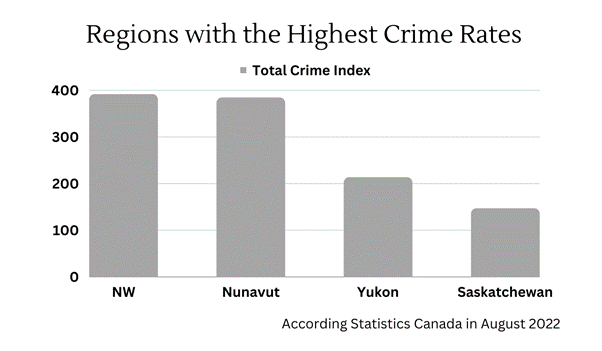
Some territories/provinces with the highest recorded crime rates in 2021 are as follows. Note that the total crime index is calculated by dividing the total number of crimes reported to the police by the total population of that country (or region) and then multiplying the result by 100,000.
You could also consider it the number of crimes per 100,000 people in any given area.
Northwest Territories
The total crime index was 391.3. This is a decrease of 6% from the previous year.
Cabin Radio is a local news organization that receives funds from the Government of Canada. It provides news insights on the socio-political situation in Canada. One of their releases states that perpetrators committed 22,967 crimes in Canada in 2019, and 4961 were violent crimes.
Nunavut
The total crime index was 384.1. This is an increase of 2% from the previous year.
In 2019, 17,999 crimes were reported to the police, and 4,215 were violent crimes. The most common crimes were:
- Sexual Assault
- Verbal Abuse
- Assault Cases
Yukon
The total crime index was 213.3. This is a decrease of 1% from the previous year.
Most of the killings in Yukon were due to gang activities. In 2019, there were 9,720 crimes, according to the police, and among them, 2,088 were violent cases. The most common offenses observed in Yukon, according to Statistics Canada, are:
- Sexual Assault
- Smuggling of cocaine
- Trafficking
- Fraud
- Burglaries
Saskatchewan
The total crime index was 146.8. This is an increase of 3% from the previous year.
Particularly in Saskatchewan, 77% of the homicide cases were locals, who represented 18% of the region’s population.
An article by the Canadian Press in Saskatoon Star Phoenix states that in 2021, Saskatchewan had the most significant number of homicide cases. It is important to note that most of them included firearms. The increase in such killings was 9% higher than in 2020. Gang-related killings were also at their peak in Saskatchewan. The exact figure was 2.12 per 100,000 people.
Why Is the Rate of Crime Increasing in Canada?
The Trumpet is an organization that claims to explore each news detail with striking depth. In one of their articles, they mention the reasons why crime in Canada has been on the rise in recent years.
Lenient Legal System
- The Canadian Government revoked many of its laws relating to sex offenders in 2018. This includes eliminating the requirement for such offenders to be added to the national registry for life or if their offenses exceed one.
- Furthermore, they proposed that if bail conditions are reasonable, then criminals could be released at the earliest instead of receiving detention. This is, unfortunately, without considering the possibility that the offender can repeat their acts.
- Laws on armed offenses and those including drugs, for example, tobacco, have also been eased.
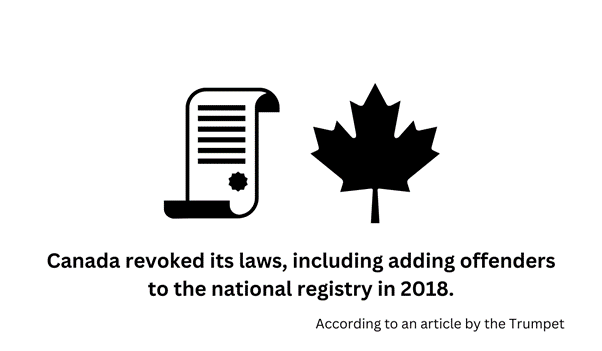
The Impact of COVID on Crime in Canada
Simon Fraser University (SFU) is one of the leading platforms in research and strategic planning. According to global and national rankings, they are among the top 15 research universities.
Professor Martin Andresen is a criminologist at SFU and conducted a collaborative study with Professor Tarah Hodgkinson from Wilfrid Laurier University to analyze how the pandemic affected different types of crimes. They chose ten crimes of varying natures among 22 neighborhoods in Vancouver. Their findings are as follows:
- Following the closure of many businesses, the property crime rate decreased significantly in downtown areas.
- However, in much wealthier neighborhoods, property crime did increase as well.
- Assault crimes were also seen to increase (forms of assault that involved a great deal of frustration).
- Issues like homelessness and addictions are the primary reasons for the rise in crime following the pandemic.
Does Poverty Increase Crime in Canada?
The same collaborative study published on SFU also cites increased crime in poverty-stricken neighborhoods (in Vancouver). This is mainly because of a shortage of basic resources to accommodate all the inhabitants of any particular setting. The crimes in these areas were mostly violent in nature. These were largely due to drug addiction, alcohol abuse, homelessness, and struggles with mental health.
In another report, Statistics Canada mentions that neighborhoods with relatively low-income households report much more social disturbances than those with higher-income households.
CBC Radio Canada is a broadcasting service that provides reliable news insights. They aim to connect all communities within Canada on one platform, believing it encourages a democratic nation.
In a release from November 07, 2019, it is stated that experts believe that the main causes for an increased crime rate are no other but poverty, mental health struggles, and inequitable distribution of resources, that is, social disparities. Canada has also seen a very high child poverty rate in many regions. Most situations are a war on the poor.
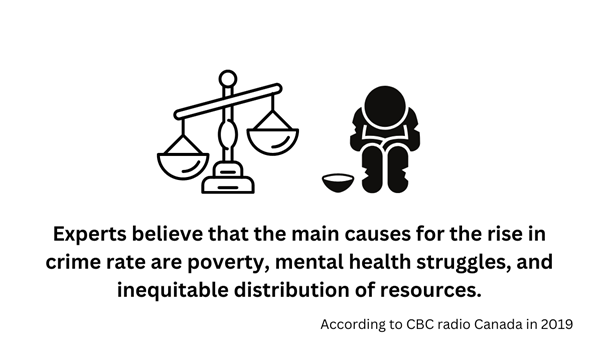
Is Canada Too Soft on Crime?
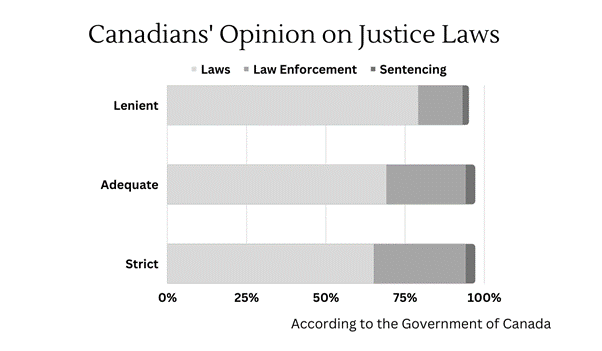
As mentioned under the heading for the reasons for crime in Canada, the most important cause for increased crime is easing offenders’ punishments. In 2018, Trudeau’s Government made bail much easier for offenders despite the possibility of them committing the same crimes again.
The official website of the Government of Canada presented a report containing the opinions of Canadians on their justice laws.
Opinion on Sentencing
Among the people polled, 79% consider their sentencing laws too lenient. However, 14% of them thought that the laws were adequate. Only 2% of people believed that the laws were too strict.
Opinion on Enforcement
Similarly, 69% of responders think they are too lenient when enforcing laws. 25% of them believe that they are adequate, whereas 3% consider them to be too strict.
Opinion on Original Laws
Lastly, when the original laws were presented to the pollers, 65% thought they were generally too lenient. 29% thought they were right, and 3% were too strict.
In line with the statistics presented above, the majority’s opinion is that the Canadian laws for offenders are lenient and need revision if they are to suppress the rapidly increasing crime rate. If not, the national crime rate may continue to rise and ultimately disrupt the balance in society.
Conclusion
Conclusively, it is not incorrect to state that crimes have increased over recent years. However, this is not due to one factor alone. The global pandemic played a pivotal role in raising the crime rate, as it was a time of desperation and frustration where people had scarce resources to survive. This period eventually led to a striking increase in theft and fraud, often involving firearms.
Drug abuse and smuggling were on the rise, too, in an attempt to make money to get through the pandemic.
One of the primary causes for such lawlessness is the Canadian Government’s lenient laws against criminals. According to a report that contained the opinions of the indigenous people, a vast majority agreed that law enforcement and sentencing laws were extremely lenient.
Canada is undoubtedly quite soft on crime, as evident from the statistics by numerous credible organizations. However, if they reform their laws to be more strict and with defined punishments for different types of offenders, the crime rate will most likely decrease.

